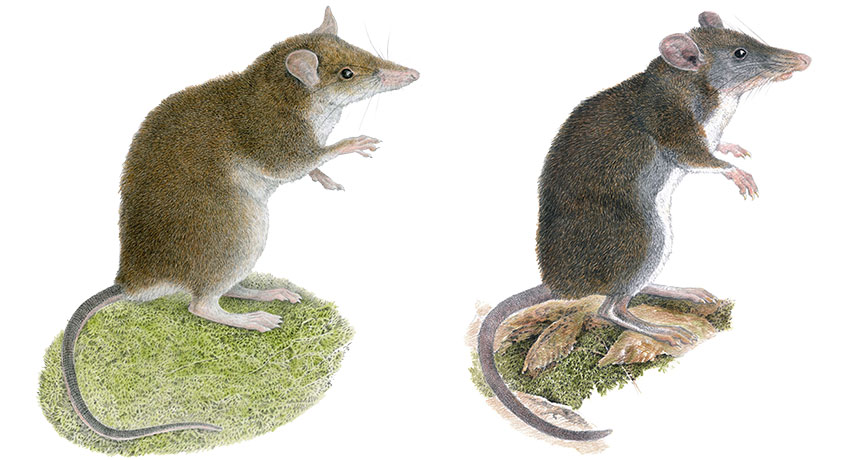
NEW FACES Two new species of shrew-rat (Rhynchomys migan illustrated at left, R. labo at right) were found high up on mountain slopes in the Philippines.
Velizar Simeonovski/Field Museum
- More than 2 years ago
Two newfound species of shrew-rat have joined a lengthy list of endemic mammals on Luzon, the largest island in the Philippine archipelago and a hotbed of biodiversity. Researchers made their discovery thanks to wriggling worms and a stroke of luck, and hope the finding might help sway legislators to protect the vulnerable ecosystem before it’s too late (SN: 6/8/19, p. 5).
The new species, Rhynchomys labo and R. migan, sport plush fur, pointed snouts and kangaroo-like feet, researchers report June 6 in the Journal of Mammalogy. The distinctive rodents once eluded field scientists, snubbing the standard rodent bait of roasted coconut slathered in peanut butter. It wasn’t until unwary shrew-rats stumbled into a trap that scientists learned that the animals prefer a more succulent snack: earthworms.
“We baited our traps with earthworms, and the next day we had a couple dozen of these things,” says Eric Rickart, a curator of the Natural History Museum of Utah at the University of Utah in Salt Lake City.
Rickart, along with Lawrence Heaney of the Field Museum in Chicago and many other collaborators, applied this knowledge at field sites across Luzon. In the late 2000s, expeditions to Mount Labo and Mount Mingan revealed two unknown shrew-rat populations, found above 1,250 meters and 1,450 meters, respectively. After comparing the animals with four known Rhynchomys species, the researchers confirmed their discovery and named the new species after their mountainous habitats.

The scientists had expected to find unrecognized species hiding out in the towering mountains. Mammalian diversity abounds on mountain slopes in part because the peaks isolate populations of related animals. Shrew-rats and their rodent relatives all likely evolved from a single ancestor, whose population scattered upon arriving on Luzon, Rickart says. Then each group adapted to the particular conditions found on different mountains over time, evolving into separate species.
“Almost every mountain [in the region] has its own small rodent species,” says biologist Arturo Ramírez-Bautista of the Instituto Politécnico Nacional in Oaxaca, Mexico, who was not involved in the study. “These endemic species represent unique evolutionary histories and lineages, thus unique sources of genetic diversity, that are about to be lost forever.”
Only about 6 percent of the Philippines’ original old growth forest still stands after decades of extensive logging, and the remaining forest faces threats from mining and geothermal development (SN Online: 9/13/18). The degraded watershed leaves surrounding areas vulnerable to flooding and landslides, especially during typhoon season.
Conservation efforts in the Philippines have seen some success, Rickart says, but more protections must be enacted to keep local communities of both shrew-rats and humans intact.






